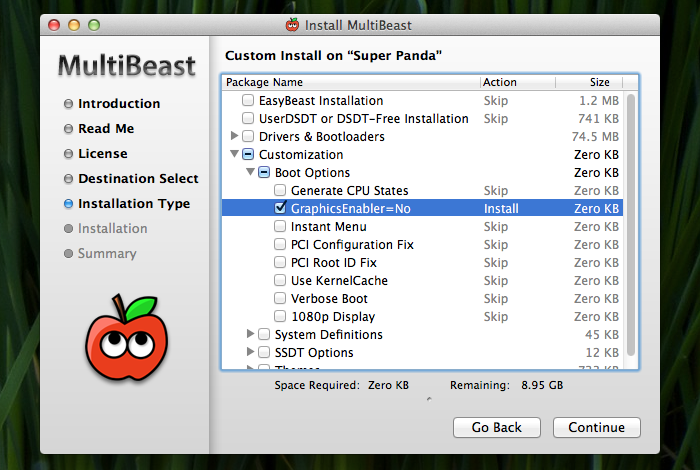Radeon 6470m Kext Installer
Oct 25, 2011 - message on boot and it says the ati6000 controller kext could not be loaded. What did other people. Re: Radeon 6470m Project The boot file.
I have an early 2011 MacBook Pro that is affected by the well known problem on the graphics card (AMD 6490M 256MB). Hopefully waiting for an Apple replacement program I want to disable the discrete graphics and enable only the Intel HD3000 chip in the i7. I have been able to access the system by running these commands in 'Single User Mode': $ mkdir /DisabledExtensions $ mv /Library/Extensions/AMD* /DisabledExtensions/ After that the Mac boot up in Mavericks but I have no graphic acceleration whatsoever, every animation is very slow. I can't change the brightness of the screen, the color calibration is different. Under 'Settings >Objyasniteljnaya zapiska o nedostachah i izlishkah na sklade. Monitor' shows that the computer is attached to an external monitor. I have installed gfxCardStatus v2.2.1 which shows that I am running on the discrete graphics card and there is no chance to switch to integrated one.
Even though I can see that the HD3000 Extension is loaded: $ kextstat grep HD3000 110 0 0xffffff7f837dc000 0x62000 0x62000 com.apple.driver.AppleIntelHD3000Graphics (8.2.4) The apple customer service says that they don't have an 'official' procedure to disable the discrete graphics card. Here are the specs: Processor: 2 GHz Intel Core i7 Memory: 4 GB 1333 MHz DDR3 Graphics: AMD Radeon HD 6490M 256 MB Software: OS X 10.9.5 (13F34). Disabling the ATI/AMD kernel extensions will not force the OS to switch to the Intel integrated graphics. It's a misconception in all the fixes/instructions out there. All that does is running the discrete chip with a fallback driver with no graphic acceleration. This is akin to seeing the '640x480 VGA' standard display mode on Windows back in the day whenever it cannot load the proprietary GPU driver.
Same GPU is being used, just not at its full capacity. Here is what happens after disabling the AMD/ATI extensions: • The black screen (no display) problem is usually fixed. • However there is no graphic acceleration. • Existing or new graphics defects(blue or pink bars/lines, jagged/out-of-order image, noise, etc.) will show up as temperature fluctuates (running GPU at high temp, power on/off, etc.), presumably due to the lead-free solder problem. • The defects are present at the boot time. • The internal LCD is treated as an external monitor, with only one possible resolution: the maximum display resolution (1440x900 or 1680x1050).
• When the laptop LCD is used, it stays on full brightness and does not turn off when the lid is closed. This physically damages the screen as time goes (doesn't take long, several weeks will do). • A Thunderbolt external display can be used if the laptop lid is shut at the boot time (before image showing up on the laptop LCD). • Only one display device is recognized, either the laptop LCD or an external Thunderbolt monitor. There is no mirroring or extending when using an external monitor. • The laptop LCD will stay off when using an external monitor. The only method I know that triggers the integrated graphics switch is the overheat-shutdown method.
0 (optional). If you can get the display to show up using the disable-kernel-extensions method, set your account to auto-login. Install or a similar tool to automate step 3 below. • Let the Macbook Pro overheat in a blanket or closed bag in order to force an auto-shutdown. • Immediately turn it back on.
It should be using the integrated graphics. • Quickly switch to integrated graphics using gfxCardStatus (with proper setting in System Preferences/Energy Saver). The problem with this method is that the OS will switch to discrete graphics whenever you run some app that uses graphics acceleration. So this is not a permanent solution. The reality is, as long as the GPU BGA sits on top of those RoHS solder balls, the disable-kernel-extensions method will also start to fail at some point. The only lasting solution is reballing the GPU BGA with lead solder, if you have given up on Apple. Finding a reliable reballing service that understands temperature profiles and follows proper soldering techniques is yet another hurdle.
